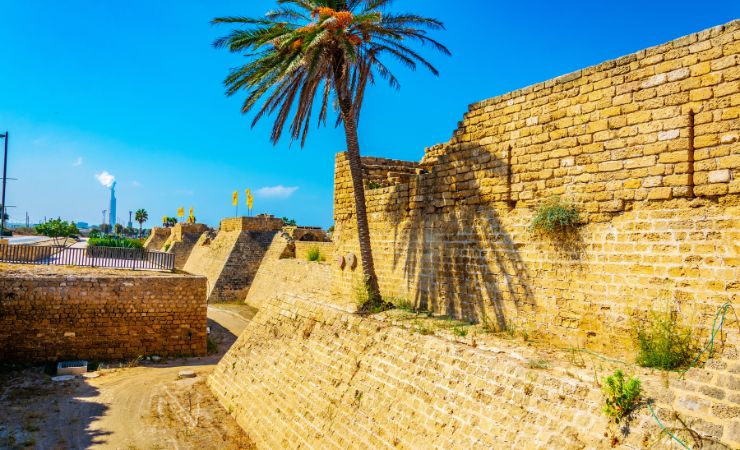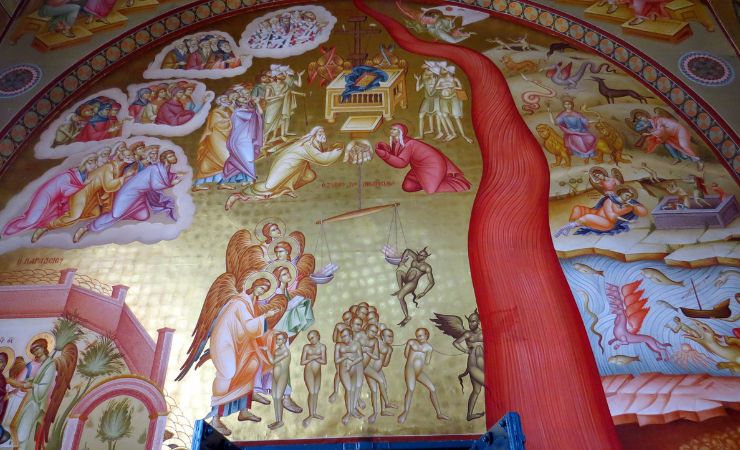Main Crusader Castles and Churches in Israel
Israel is a land steeped in history, where the past echoes through ancient ruins and fortifications scattered across its diverse landscapes. Among the most fascinating relics are the Crusader forts and churches, remnants of a turbulent period when European knights and pilgrims set out to capture and defend the Holy Land. From the majestic Belvoir Fortress overlooking the Jordan Valley to the towering walls of Acre, these sites tell stories of conquest, faith, and conflict. This guide explores the most notable Crusader sites in Israel, offering a journey through medieval history and architecture.

Knights Hall in Acre
The ancient port city of Acre, also known as Akko, is located in northern Israel on the Mediterranean coast. A pivotal Crusader stronghold, Acre was the capital of the Kingdom of Jerusalem in the late 13th century. The Knights Hall was built by the Knights of the Hospital of Saint John. The Knights Halls complex in Acre was the main fortress and headquarters of the Crusaders during the 12th-13th centuries. The complex includes several impressive halls, such as the Columns Hall (dining room), which is considered a symbol of the transition from the Romanesque to the Gothic architectural style. Another significant hall is the Pillars Hall, which served as a conference and storage room for the knights of the Order. The Knights Halls also feature a unique public toilet system, which is rare for its time. The Old City of Acre is a UNESCO World Heritage site, offering a unique blend of medieval and Ottoman architecture.
Safed Citadel
The Safed Citadel, situated in the city of Safed in the northern Galilee, is a prominent Crusader fortress built in the 12th century by the Knights Templar. The citadel was constructed on a hill, offering strategic control over the region. It was heavily fortified with three concentric walls and robust towers. Despite enduring multiple sieges, including one by Saladin in 1188, the citadel remained a significant military stronghold. Today, the ruins of the citadel are part of Citadel Park, offering panoramic views of the Galilee and a glimpse into the area’s tumultuous. history
Château Pèlerin (Atlit Castle)
Château Pèlerin, also known as Atlit, is a Crusader fortress situated about 2 kilometers north of the modern Israeli town of Atlit on the northern coast of Israel. The Knights Templar began its construction in 1218 during the Fifth Crusade. This fortress was one of the major Crusader strongholds, capable of supporting up to 4,000 troops during sieges. For a brief period, it served as the headquarters of the Crusaders. In August 1291, the fortress fell to the forces of Al-Ashraf Khalil, marking the end of Crusader presence in the region. The fortress remained largely intact for centuries, enduring the Galilee earthquake of 1837. Today, the castle is part of the Atlit naval base, a training zone for Israeli Naval commandos.



Montfort Castle
Montfort Castle is located in the Upper Galilee, nestled within the Nahal Kziv nature reserve. Constructed in the mid-13th century by the Teutonic Order, this castle served as the order’s main headquarters after they relocated from Acre.
This fortress was the primary stronghold of the monastic military Teutonic Order in the Holy Land. Montfort is perched on a narrow ridge with steep slopes, reminiscent of the fortresses in the Teutonic Order’s European homeland. The castle’s name, “Montfort,” translates to “strong mountain,” echoing its formidable nature.
Unlike many Crusader fortresses, Montfort was not initially erected for military defense but was intended to house the order’s administrative functions, including its archives and treasury. This decision was influenced by the order’s desire to relocate some of its operations from the bustling port city of Acre to a more secluded setting. The castle’s design is characterized by its elongated two-storey hall-type central structure, which remains a significant remnant today. Despite its non-military origins, Montfort faced sieges, until fell to the Mamluks. The castle’s construction, particularly the keep, showcases high-standard building techniques, evident in the precision of the stonework. This craftsmanship suggests that the Teutonic Order undertook a significant rebuilding effort in the early 13th century. Ultimately, Montfort’s significance lies not just in its architectural grandeur but also in its representation of the Crusaders’ legacy in the region.
Nimrod Fortress
Nimrod Fortress, also known as “Qal’at al-Subeiba,” is the largest Crusader-era fortress in Israel, strategically perched on the slopes of Mount Hermon. Originally constructed by the Muslims in the 12th century, it was later taken over and fortified by the Crusaders before being recaptured by the Muslims. The fortress includes massive walls, towers, and a deep moat. Its most notable features are the large keep, a secret passageway, and the panoramic views of the Golan Heights. Today, it stands as a significant historical and archaeological site, drawing many visitors who are fascinated by its impressive remains and historical significance.
This fortress was the primary stronghold of the monastic military Teutonic Order in the Holy Land. Montfort is perched on a narrow ridge with steep slopes, reminiscent of the fortresses in the Teutonic Order’s European homeland. The castle’s name, “Montfort,” translates to “strong mountain,” echoing its formidable nature.
Unlike many Crusader fortresses, Montfort was not initially erected for military defense but was intended to house the order’s administrative functions, including its archives and treasury. This decision was influenced by the order’s desire to relocate some of its operations from the bustling port city of Acre to a more secluded setting. The castle’s design is characterized by its elongated two-storey hall-type central structure, which remains a significant remnant today. Despite its non-military origins, Montfort faced sieges, until fell to the Mamluks. The castle’s construction, particularly the keep, showcases high-standard building techniques, evident in the precision of the stonework. This craftsmanship suggests that the Teutonic Order undertook a significant rebuilding effort in the early 13th century. Ultimately, Montfort’s significance lies not just in its architectural grandeur but also in its representation of the Crusaders’ legacy in the region.
Read Article About Nimrod Fortress
Belvoir Castle
Belvoir Fortress, known as “Kochav HaYarden” in Hebrew, is situated 20 kilometers south of the Sea of Galilee in northern Israel. Built by the Knights Hospitaller in the late 12th century, this fortress was a strategic stronghold designed to protect the eastern border of the Crusader Kingdom of Jerusalem. Belvoir, meaning “beautiful view” in French, aptly describes the panoramic vistas it offers over the Jordan Valley.
The castle was initiated by Gilbert of Assailly, Grand Master of the Knights Hospitaller, in 1168. It was constructed to guard the Crusader Kingdom of Jerusalem from eastern invasions.
Its strategic location 500 meters above the Jordan River Valley allowed it to command the route from Gilead into the Kingdom of Jerusalem.The fortress features a concentric design with a central keep, surrounded by a moat and thick defensive walls, which withstood a prolonged siege by Saladin’s forces before falling in 1189. Today, the well-preserved ruins, including the formidable gatehouse and towers, are a popular tourist site, managed by the Israeli National Parks Authority.
The Crusader Fortress at Apollonia (Arsuf)
Apollonia was a significant Crusader stronghold located on Israel’s Mediterranean coast near Herzliya. Captured in 1101 by Baldwin I, it served as a vital defensive and administrative center.
The fortress, completed in 1241 by the Knights Hospitaller, featured robust fortifications including an outer wall with semi-circular towers and a wide moat, a middle fortification with additional towers and a fortified gate, and an inner keep. Strategically situated on cliffs overlooking the sea, it provided control over the coastal area. In 1265, Mamluk Sultan Baibars captured and demolished the fortress after a 40-day siege, effectively ending Crusader control.
Today, the site is part of Apollonia National Park, showcasing well-preserved ruins, scenic coastal paths, and interpretive displays.
Antipatris (Tel Afek)
Antipatris was a city established during the first century BCE by Herod the Great to honor father, Antipater. Today, the site is a national park in central Israel and is recognized as Tel Afek. During the Crusader Period, the site was referred to as “Surdi fontes” or “Silent springs”. The city’s strategic importance was due to its position at the strong perennial springs of the Yarkon River, which historically created a barrier between the hill country to the east and the Mediterranean to the west. This forced travelers and armies to pass through the narrow pass between the springs and the foothills of Samaria. Antipatris was situated on the Roman road from Caesarea Maritima to Jerusalem, just north of the town of Lydda.
Migdal Tzedek (Mirabel)
Migdal Tzedek, also known as Mirabel, is situated near Rosh HaAyin in central Israel. This fortress was constructed in the early 12th century by the Crusaders to fortify the region and protect the important road from Jaffa to Jerusalem. The fortress features thick defensive walls, a central keep, and several towers. Over the centuries, it has been modified and expanded by various rulers, including the Ottomans. The ruins today offer a fascinating glimpse into medieval military architecture and are part of a national park, providing scenic views and historical insights.
Antipatris
Antipatris, located near Rosh HaAyin, was an ancient city that the Crusaders fortified in the 12th century. The fortress was strategically placed to protect the vital road from Jaffa to Jerusalem. The site features the remains of Crusader walls and towers, built on top of earlier Roman and Byzantine structures. Over the centuries, it has seen numerous battles and changes of control. Today, the ruins of Antipatris are part of the Yarkon National Park, offering visitors a chance to explore the historical layers of this significant site.

The Crusader Church in Ramla
The Crusader Church in Ramla, now known as the Great Mosque or Al-Omari Mosque, is one of the few Crusader buildings in Israel that has survived almost completely intact. Originally built in the 12th century as the Cathedral of St. John the Baptist by the Crusaders, the structure is a classic example of Crusader architecture. It features a basilica layout with three parallel halls, a nave, and two transepts, creating a spacious and impressive interior.
After the Mamluks conquered Ramla in 1266, Sultan Baybars converted the church into a mosque in 1268. This transformation included the addition of a mihrab (prayer niche) pointing towards Mecca and a minbar (pulpit) for the imam’s sermons. The eastern wall’s large niche, originally the church’s apse, remains a significant architectural feature. The mosque also features a minaret, added later in 1314, which continues to call the faithful to prayer.
Today, it is an active mosque, and visitors can appreciate both its historical significance and architectural beauty.
Church of the Resurrection Abu Gosh
In the heart of Abu Ghosh, a village near Jerusalem, stands the Church of the Resurrection, a testament to the architectural prowess of the Crusaders in the 12th century. This church, constructed by the Hospitallers, is one of the most well-preserved Crusader structures in the Holy Land. Built atop the ruins of a Roman water reservoir and an Abbasid caravansarai, the church showcases a harmonious blend of late Romanesque and early Gothic architectural styles. Named “The Church of the Resurrection,” it was historically associated with the biblical town of Emmaus, where Jesus is believed to have made an appearance after his resurrection. The church’s walls, adorned with intricate frescoes from the 1170s, offer a rare glimpse into the artistry and religious fervor of the Crusader period. These frescoes, remarkably preserved, are among the finest examples of Crusader artwork in the region. The church’s strategic location and architectural significance make it a vital link in understanding the Crusader’s influence in the Holy Land.
Read more about the Church of Resurrection.
Tower of David
The Tower of David, or the Citadel of Jerusalem, is located near the Jaffa Gate entrance to the Old City of Jerusalem. The site has served as a strategic fortress for centuries, with its current form dating back to the Mamluk and Ottoman periods. However, the foundations include significant Crusader-era structures. The Crusaders fortified the site extensively during their occupation of Jerusalem in the 12th century. Today, the Tower of David is a museum that chronicles Jerusalem’s long and varied history, featuring exhibits on the city’s different rulers, including the Crusaders. The citadel offers panoramic views of Jerusalem and is a centerpiece of the Old City’s historical and cultural. landscape
The Tomb of the Virgin Mary in Jerusalem
Mary’s Tomb is situated just north of the Garden of Gethsemane in the Kidron Valley. The Church from the time of the Crusaders was round in shape, but had not survived. What remains is a subterranean shrine believed to be the resting place of Mary, the mother of Jesus. The walls of the shrine have been blackened over the centuries due to candle smoke.
The Crusader church consisted of an upper church, which was built over the ruins of the earlier Byzantine structure, and a lower church, which included the crypt believed to be the actual tomb of the Virgin Mary. The upper church was destroyed by Saladin in 1187, with its masonry repurposed to repair the walls of Jerusalem. However, the lower church, along with the crypt, remained intact.
The entry to the tomb is through a wide descending staircase, which is a notable feature of the Crusader construction. The staircase, part of the Crusader renovations, leads to the crypt where Mary’s body is believed to have been laid. This crypt is designed in a cruciform shape with uneven arms, adding to its unique architectural layout.
Read more about the Mary’s Tomb.
The Crusader Church of Saint Anne in Jerusalem
St. Anne’s Church, located near the Lions’ Gate in the Muslim Quarter of Jerusalem, is one of the best-preserved Crusader churches in the city. Built between 1131 and 1138 during the reign of Queen Melisende, the church stands on the site traditionally believed to be the birthplace of the Virgin Mary, the mother of Jesus. This location was chosen because of its proximity to the Pools of Bethesda, where, according to the Gospel of John, Jesus healed a paralytic.
The church is a splendid example of Romanesque architecture, featuring strong lines, thick walls, and a basilica layout with three aisles, cross-vaulted ceilings, and a somewhat austere interior. The asymmetry in its design, such as mismatched columns and differently sized windows, adds to its unique charm. The high altar, crafted by the French sculptor Philippe Kaeppelin, depicts various scenes from the life of the Virgin Mary.
Unlike many other Crusader structures, Saint Anne’s Church was not destroyed after the Muslim conquest of Jerusalem in 1187. Instead, Saladin converted it into a madrasa (Islamic school) known as Al-Madrasa As-Salahiyya. This adaptation is still commemorated by an Arabic inscription above the main entrance.
Today, the Church of Saint Anne is administered by the White Fathers, a Catholic missionary order. It is renowned for its exceptional acoustics, making it a popular destination for pilgrims and choirs.
Read more about St. Anne’s Church
The Room of the Last Supper in Jerusalem
The Cenacle, also known as the Upper Room, is traditionally held to be the site of the Last Supper. Located on Mount Zion in Jerusalem, just outside the medieval Old City walls, this room has undergone numerous cycles of destruction and reconstruction, culminating in the structure that stands today. Here’s what can be found from the time of the Crusaders:
The current building that houses the Cenacle is of medieval date. This means that while the site itself is ancient and associated with the Last Supper, the actual structure that visitors see today has its origins in the medieval period, which includes the time of the Crusaders.
The building’s foundation is a remnant of Hagia Zion, a church that existed during the Crusader period. This foundational element is a testament to the various religious structures that have occupied this site over the centuries.
The Cenacle stands tall on Mount Zion, nesting above what is traditionally considered David’s tomb. This location is significant because the only specific information we have from the Last Supper accounts is that Jesus and his apostles secured a large furnished space, the upper room of an unnamed householder in Jerusalem.
The building has experienced numerous cycles of destruction and reconstruction, with the current structure being of medieval origin, which aligns with the time of the Crusaders.
The general location of the Cenacle is also associated with the house where the Virgin Mary lived among the apostles until her death or dormition, an event celebrated in the nearby Church of the Dormition.
Pilgrims have reported visiting a structure on Mount Zion commemorating the Last Supper since the 4th century AD. Some scholars believe that this was the Cenacle, which might have been a synagogue from an earlier time. The building’s foundation is a remnant of Hagia Zion, which was originally built as a church and later repurposed during the Crusader period.
The “Tomb of King David” is located on the lower level of the same building. This niche is traditionally associated with the burial site of King David, marked by a large cenotaph-sarcophagus first reported by 12th-century Crusaders.
The Church of the Holy Sepulchre in Jerusalem
The Church of the Holy Sepulchre, located in the Christian Quarter of the Old City of Jerusalem, is considered the holiest site for Christians. It has been a significant pilgrimage destination since the 4th century. Over the centuries, the church has undergone several major phases of construction and renovation. Here are some of the structures and features from the time of the Crusaders that can be found in the Church of the Holy Sepulchre:
Crusader Renovation: The church underwent significant changes during the reign of the Crusader kings in the 12th century. This renovation has largely stood the test of time and is what visitors predominantly see today.
Crusader Campanile (bell tower): This bell tower was constructed during the Crusader period and is a prominent feature of the church.
Crusader Patriarchate: This was the seat of the Roman Catholic patriarch during the Crusader period.
Ruins of the Crusader Arcade: Remnants of an arcade built during the Crusader era can still be seen.
Chapel of the Franks (10th Station of the Cross): This chapel is associated with the Crusader period.
Greek Calvary (12th–13th Stations of the Cross): This area of the church, associated with the final stations of the Cross, has elements from the Crusader period.
Latin Calvary (11th Station of the Cross): Another area associated with the Crucifixion and the Crusader era.
Chapel of the Angels, Chapel of St. Michael, Chapel of St. Mary of Egypt, Chapel of St. Thecla, Chapel of St. James the Less, Chapel of Forty Martyrs, Chapel of St. Helena, and several others: These chapels within the church complex have elements or were influenced by the Crusader period.
The Church of the Holy Sepulchre is a complex structure with a rich history, and the Crusader period left a significant mark on its architecture and layout. The Crusaders made substantial changes to the church, many of which are still visible and form an integral part of the church’s character today.



